ISIS’s ‘caliphate’ was crushed. Now Syria’s Kurd-led alliance faces bigger battles
Reporting from shattered Syria in the dying days of the caliphate, Jared Szuba talks to Kurds and Arabs about the fight for their shared future
In the last days of Islamic State’s professed caliphate, under the cover of thunder and heavy rain, Coalition aircraft bombed an ammunition depot south of the Syrian village of Baghuz.
The detonation touched off a cluster of fires in the cult’s densely-inhabited encampment.
The next morning, more than one thousand of the remaining believers gathered at the foot of Mount Baghuz to surrender to the alliance of Syrian militias that surrounded them on three fronts. To their south lay the Euphrates riverbank, within range of the Syrian Arab Army across the water.
For weeks their tents had been raked with automatic fire, their zealous mujahideen picked off by the polished snipers of the predominantly Kurdish People’s Protection Units (YPG). Each night, their dugouts and shelters were slammed from all sides with American and French 155mm artillery and 120mm SDF mortars.
“Strike and wait, strike and wait,” a stocky Syrian Democratic Forces conscript told me at the base of the cliff. The progress was grueling. “We’re advancing, but can’t with the civilians in front,” he said.
Every few days the jihadists called for an evacuation, and the main assault halted. But sniper operations continued, cadre said, to prevent them from exploiting the quasi-ceasefire.
“They send the civilians out then they stay. We keep telling them, ‘Whoever doesn’t surrender, dies.’”
Behind him, a procession of black veils shuffled up the path, contrasting with the sandy bluff illuminated by the setting sun. They clung to dirty children, some crying.
A lanky teenager with a Kalashnikov gestured to the bags born by one of the black forms. Without hesitation, she jettisoned the luggage down the cliff.
“That’s the last group!” someone shouted in Arabic. A gang of fighters shouldered their rifles and jumped off sandbags, skidding and jogging down the gravel path towards the front. One told me to leave the area. “It’s going to begin again any minute.”
I legged it back to the van and climbed in. Half a football field ahead, two American-made Humvees bearing the yellow flag of the SDF squatted before of a one-story concrete home.
On the roof, silhouetted against the sun through palm fronds, two fighters extended the bipod of a PKM with casual proficiency. As we pulled away, the crackle of small arms fire broke out, then grew into a steady rhythm. A Dushka chugged away somewhere behind.
“Their resistance is softening,” said Haval Ahmed, my 20-year old escort.
“It’ll probably end within days.”

The ground war against Islamic State has been declared finished. Coalition bombs are still pounding the last stragglers holed up under the south face of the cliff.
At a safe house a few kilometers north of the front, veteran SDF fighters told me Baghuz had been the most taxing fight of their war against ISIS.
“Honestly when we came here, we expected a big battle. But not these enormous numbers,” Mervan Qamishlo of the SDF’s Military Media Command said.
As we spoke, the ostensible caliphate that had once stretched nearly from Aleppo to Baghdad was being measured in square meters.
Already synonymous with savagery, the death cult nearly outdid itself in its last stand. Women and children returned fire on the SDF, an officer at the front said, and at least one surrendered mujahid said their leaders were withholding food from those who refused to fight.
The day after I arrived, a delegation of black-veiled suicide bombers mingled with the evacuees only to detonate among their own, wounding a handful of SDF guards.
Veteran jihadists from Anbar, Afghanistan, Chechnya and Turkey commanded the last of the believers, Mervan Qamishlo told me.
The hardened cadre had slipped past the Iraqi Army at Mosul and the YPG in Manbij, fled Raqqa and pulled back across the desert plain of Deir Ezzor, Hajin, and Sousa under catastrophic bombardment.
But if Daesh’s “elite” had concentrated in Baghuz, the same was true for their adversaries.
With every city the fanatics fled over the past four-and-a-half years, they surrendered thousands of their able-bodied survivors to a confederation of Western-backed militias that promised revenge, and a place in a new Syria.

Detachments from the YPG, its all-female counterpart the Women’s Protection Units (YPJ), and the Syriac, Manbij, and Deir Ezzor Military Councils, as well as former Free Syrian Army factions such as the Liwa al-Shamal al-Dimokrati (Northern Democratic Brigade) and Jaysh al-Thuwar (Army of Revolutionaries), congregated for the final thrust of the war. (That SDF representatives in Baghuz could not account for all units participating signalled both the unity and urgency of their cause.)
Salih, a 20-year-old self-professed forward observer from Hasakah, had joined the YPG three years earlier “to fight terrorism.” We spoke on the roof of the house, overlooking miles of ruins that stretched from the Euphrates to the Iraq border.
After Baghuz, he said, he wanted “to go home.”
“We’ve finished the end of the road,” Salih, an Arab who previously had been affiliated with a Sunni rebel group, said. He stared over the sunlit battlefield with a sharp, empty gaze.
“This is the end of Daesh … We’ve liberated ourselves from terrorism inshahallah,” he said”We want a homeland so we can just live in security.”
For others, the fight was far from over.
Inside the house, a group of tired recruits just back from the front huddled on the floor scooping heaps hot rice and chicken from styrofoam trays.
I asked what they expected next after Baghuz. They hesitated, keeping their eyes on the food. A burly fighter in his late twenties took the opportunity to speak for them.
“We’ve had enough of war,” he said. He gave his name as Salaheddin.
A five-year YPG veteran who fought at al-Hol, al-Shaddadi, Manbij, Raqqa, and other battles – more than he could now recall – Salaheddin was on his third tour of the Deir Ezzor campaign.
“We’d love to rest,” he said, before adding, “we have much work ahead. Daesh isn’t finished. There are a lot of sleeper cells.”
“After we finish with the sleeper cells,” he paused, then gave a sly grin. “I’m not able to talk about that.”

Threat of Turkish invasion
The SDF declared Saturday it has taken a staggering 32,000 casualties in the conflict. If accurate, the losses are more than half the Pentagon’s estimate of its current forces. 11,000, including civilian volunteers who took up arms in Kobane and Efrin, are believed to have died.
The half-decade war against the Islamist genocidaires will one day be seen as the easy part, northern Syrian officials told The Defense Post.
To the north of their nascent territory, Turkey’s President Recep Tayyip Erdogan is openly vowing a military assault to destroy the YPG and to purge its political arm, the Democratic Union Party (PYD), from local governance and re-settle hundreds of thousands of Syrian refugees into Kurdish-majority areas in the north.
YPG officials, some known to be former members of the Kurdistan Workers’ Party (PKK), have long sought to distance the Syrian project from the insurgent group, but Turkey isn’t buying it.
The Washington establishment may have called Erdogan’s bluff on an invasion for now, but northern Syrian officials are taking the threats very seriously. In 2017, Turkey launched an incursion into Efrin that displaced hundreds of thousands of people, mainly Kurds, in an act yet to be labeled by any international body as an ethnic cleansing.

To the south, Syrian Defense Minister Ali Abdullah Ayoub last week reiterated his government’s demands for the north’s total capitulation and reintegration into the pre-war Baathist system, under which Kurds were denied citizenship for decades.
A regime assault would “only lead to more losses, destruction and difficulties for the Syrian people,” the SDF responded.
The Kremlin, having offered to mediate a favorable outcome for the north, now say they can do little to sway Assad, northern Syrian officials say.
Within their current borders, the conflict has dumped tens of thousands of ISIS prisoners and their families into under-prepared internment camps. Northern Syrian authorities are now calling for U.N.-led and financed international tribunal to be held in Rojava (the Kurdish name for majority-Kurdish lands in northern Syria), their previous requests for the repatriation of foreign fighters mostly ignored.
Without formal international recognition, heavy artillery, armor or aircraft, the fledgling province’s fate may be largely out of its leaders’ hands for now.
Democratic project in northern Syria
In the meantime, northern Syrian authorities are managing matters within their control.
“We have defeated ISIS militarily. Now, we must do so ideologically,” said SDF media chief Mustafa Bali.
The north’s security institutions are set to be reorganized to focus on internal security operations. Officials are tight-lipped about details, but both the SDF and Asayish, or police forces, have already received new training programs focusing on hunting ISIS sleeper cells and dealing with explosives.
The U.S. Defense Department has requested $300 million in the 2020 budget for “vetted Syrian opposition” partners, including increased outfitting of northern Syria’s internal security forces and $250 million to support “border security requirements” of partner forces.
“Fighting at the front is different than the internal battle,” Aldar Xelil, senior TEV-DEM foreign affairs official, explained to me in Qamishli.
“The sleeper cells are considered the hardest phase. Harder than the phase we are undertaking now,” Mervan told me in Baghuz, as gunfire rattled in the distance.
Shouldering the weight will be the Asayish and internal intelligence services. But the vanguard against whatever remains of ISIS or its ideology will be the population of northern Syria itself, officials say.

There is a perception among many northern Syrians that segments of region’s Sunni Arab population are now more religiously conservative after living years under Islamic State, so the Autonomous Administration of North and East Syria has instituted an ambitious education campaign to break down what they see is a toxic mixture of Sunni Arab chauvinism and Assadist authoritarianism.
“For 50 years this region was indoctrinated with the racism of Arab nationalism under the Baath party,” Bali said. Sectarianism, officials say, is ingrained in the Syrian constitution, legal code, and culture.
“This generation must learn and be raised [knowing] there are others such as Kurds, others such as Syriacs, others such as Christians, and it’s their right to live like you,” Bali said.
“Hussein and Mu’awiya,” early Islamic figures associated with the roots of the Sunni-Shia split, “are gone,” Bali said. “They’re dead. We need to learn how to live together.”
They will need to proceed cautiously.
The PYD’s social policies have already incurred protest in some majority-Arab areas, such as Raqqa and Deir Ezzor. Their enforcement of mandatory conscription for men and moves against political opponents have earned them some detractors among the Kurdish population.
“Every new project is met with violent reaction,” Bali told me. Nonetheless, officials say they are confident Syria’s disparate sects will embrace their stated goal of secular democratic confederalism – and a society in which women wield significant authority – once properly exposed to it.
“Society needs to breathe the oxygen of life,” Bali said. “The educational system can rescue future generations from war, from sectarian war.”
“We want to remove the barriers between nationalisms and religions,” Xelil said.
“We’re seeing a lot of progress … but we still need much time.”
They may not have it.
‘Multiple parties, not multiple armies’
The Pentagon’s reassuring gestures to the SDF belie the deeper crisis: that American diplomats have not yet found a force sufficient to replace the more than 2,000 U.S. troops maintaining stability in the north.
Nor have they found an appropriate force to man the Turkish border. Nor have they made northern Syrian officials any promises.
A residual presence of a few hundred American troops is not remotely adequate to accomplish either, former U.S. defense and national security officials say.

Northern Syrian officials have called for an international force for border protection against Turkey, and continue to receive sympathetic reassurances from the French and British.
But the Europeans say they cannot commit to a mission not led by a sizeable U.S. force. Even if American officials could wheedle Trump up to leaving, say, 1,000 residual troops, they still appear not to have an exit strategy to offer their western allies.
James Jeffrey, Washington’s pointman on the crisis, downplayed the dilemma last Friday.
“We’re not really looking to a coalition being peacekeepers or anything like that … We’re asking coalition personnel to continue to contribute and to up their D-ISIS operations, and we’re getting a pretty good response initially,” Jeffrey said.

Meanwhile, Jeffrey’s team is seeking local Syrian forces to guard the border in order to “meet everybody’s needs.”
So far that has proven elusive. Turkey rejects any YPG presence on the border, a position Jeffrey endorsed last week. “We don’t want another Qandil in Syria,” Jeffrey said, referring to the PKK headquarters in northern Iraq.
“We need defense against Turkey, not the other way around,” a northern Syrian source with knowledge of the discussions said.
Publicly, officials from the SDF’s political arm, the Syrian Democratic Council, say they believe Jeffrey’s team is working on their behalf, and that they can understand the U.S.’s strategic concerns as Turkey flirts with Moscow.
Privately, there are frustrations. Jeffrey is perceived as ingratiating to an erratic and duplicitous supposed NATO ally using the YPG issue as a political steam-valve.
Indeed the American team appears to be waiting out Turkey’s regional elections, set for March 31, to plan the next move.
The friction may well be mutual. Northern Syrian officials reject the veteran diplomat’s proposals to bring in at least two exiled Syrian militia forces, the Rojava Peshmerga and the Syrian Elite Forces (the latter affiliated with Syrian opposition leader Ahmed Jarba), to secure the Turkish border.
“Not possible,” Xelil told me. “First of all, Jarba doesn’t have the forces. Secondly, to those who liberated this region and administrate it, there’s no place for Jarba in this whole project. Where did this come from? It’s not possible.”
The Elite Forces’ brief cooperation with and integration into the SDF in 2016 and 2017 was seen as a political win for the Kurdish-led administration, but they fell out during the battle of Raqqa in 2017.
The Rojava Peshmerga is aligned with the Kurdistan Democratic Party of Syria, a political rival of the PYD closely linked to its namesake in Iraq.
“The [Rojava] Peshmerga,” Xelil said, “is a red line.” He accuses the force of being trained and funded by Turkey. “How can we trust them?”
Importing rival forces with unclear allegiances will only complicate matters, northern Syrian officials said, at a time when the SDF is striving to unify its own various components.
“Democracy means multiple parties, not multiple armies,” the source said.
“We don’t see this as in the best interest of North and East Syria’s security,” the source said, speaking to The Defense Post on the condition of anonymity.
The American team is set to discuss its “initial concept,” whatever that may be, with Turkish officials any day now.
“After this is agreed upon, then we can discuss the details,” Xelil said.
In the meantime, they have instructed northern Syrian officials not to engage with the Assad regime, a difficult seat to take.
Rebuilding Syria
Even if the U.S. can cut a deal for additional forces, the Autonomous Administration must still confront near-Sisyphean tasks.
Much of Syria’s north lies in ruins from eight years of war, and there is no coherent plan to rebuild.
Trump unilaterally cancelled $230 million set aside for the endeavor last year. The president wants the rest of the Coalition to foot the bill, and U.S. officials say the $230 million has been replaced by pledges from Gulf nations. But the city of Raqqa, which was largely destroyed by Coalition airstrikes, alone needs some $5 billion, the city’s mayor said last autumn.

Incidentally, the Saudis asked the U.S. government if Trump’s December withdrawal announcement meant they were off the financial hook (Trump’s subsequent tweet made it clear they were not).
The northern administration’s domestic legitimacy rests heavily on its ability to fight ISIS. With the caliphate gone, people will be looking for a return to normalcy.
“The SDF bring great security but it can still be hard to get basic goods. The situation is much better now than before, but we need help,” said Hassan, a shopkeeper in Tal Abyad.
Civilians who spoke to The Defense Post in Hasakah, Manbij, and other areas of northern Syria echoed similar sentiments. Whatever their opinions of the SDF, they feared the American withdrawal.
“We’re still living in a state of war,” Xelil said. “We need a number of services to be rebuilt. We’re deficient in municipal services, electricity, food distribution, healthcare. Syria in general is crushed.”
“The services in some other areas may be better, but our ambition is stronger,” Xelil said.
SDC officials have elicited the technical support of the Syrian regime in limited projects, but full reconstruction depends on a political settlement to the civil war.
And the Americans appear unwilling to offer that, likely in deference to Ankara’s long-standing opposition to the SDC’s participation in the U.N.-sponsored peace talks in Geneva.
“We need doors open for our participation in political operations,” a source with knowledge of the discussions told The Defense Post, speaking on condition of anonymity because he was not authorized to speak on the matter.
Lack of reconstruction is a serious long-term security threat, former U.S. officials said.

In Deir Ezzor, especially, tribal grievances linger from the ISIS war and the destruction of the local oil economy by Coalition bombing.
“There is animosity towards the Kurds in some Arab areas for what is perceived as heavy-handed governance or the inequitable sharing of power and resources,” said Alexander Bick, who was Syria director in Barack Obama’s National Security Council.
“That’s a fairly combustible situation. Certainly something the Defense Department is well aware of, and has tried to address by pushing the SDF to be more inclusive, but there aren’t perfect solutions to it – particularly in the absence of resources, which this administration has decided not to put in.”
US support for the YPG
In retrospect, former U.S. officials who spoke to The Defense Post say roots of today’s crisis were sown from the beginning.
On the one hand, aligning with the YPG’s tactical goals has borne perhaps the most successful U.S. Special Forces train-and-assist mission to date.
But American officials ignored the gap between their and the YPG’s strategic goals for years, an oversight that now threatens to leave one of the world’s most vulnerable populations in what appears to be an intractable geostrategic crisis.

Still, officials say, the decision to arm and support the YPG was not made lightly.
“They were problematic from a number of different angles,” a former official said, not simply for their roots in the PKK, which Turkey and its western allies have designated a terrorist organization.
For the Americans, however, the alternative was to accept a Turkish proposal to utilize Arab rebels “without even being shown evidence that these groups existed in sufficient numbers, organization, training to actually carry that out.”
The YPG was undoubtedly the most adept ground force available in northern Syria. And, two former officials said, its secular ideology proved an appealing antidote to the region’s toxic sectarianism.
“There are 20 million Sunni Arabs between Baghdad and Damascus who in important respects lack meaningful political representation in either country,” Bick said.
“So as long as this persists, we can and should expect radicalism to reemerge down the road.”
It was American planners who pushed a reluctant YPG to capture vast Arab-majority territories in Raqqa and Deir Ezzor.
“I think everybody [in Washington] recognized at the time that you didn’t want to be trying to govern large swaths of territory with Kurdish forces that would be perceived as outsiders,” Bick explained.
“We didn’t want a situation, strategically, where we’d be relying … exclusively on the Kurds.”
Hence the “snowball” method: As the YPG took territory, it absorbed local factions into a “professional coalition” – the Syrian Democratic Forces.
The challenge for the Obama administration was how to leverage the YPG’s military and organizational abilities against ISIS while ensuring that the burgeoning alliance was constituted in a way that would minimize intercommunal tensions after the war.
“We worried about all of those issues,” Bick said.
“The question is not was the choice perfect, but what were the other choices?”
“Did we think about it? Yes. Did we come up with a satisfactory answer to it? No,” he said.
“Did we think that getting ISIS out was a sufficiently important priority for the United States that we would, to some extent, have to fly the plane as we built it? Yes.”
The consequences of that decision have come home to roost. Turkey’s position on the YPG shifted fiercely after the U.S. in 2016 pushed the group to capture from ISIS the majority-Arab city of Manbij, near the Turkish border.
“It’s probably the most complex security situation, fighting situation I’ve seen in over four decades of dealing with – with fights,” then Defense Secretary James Mattis said in February 2018 when asked about Turkey’s position on Manbij.
“And it is one where I believe we are finding common ground and there are areas of uncommon ground where sometimes war just gives you bad alternatives to choose from.”

The U.S. did not have a coherent Syria policy until at least early 2018 – a year into Trump’s presidency – a former official with knowledge of the matter said.
“As the terrain changed, they moved … You end up at a place based on one decision, one decision, one more,” the official told The Defense Post on the condition of anonymity.
“There were people saying, ‘We can stop this anytime we want.’ No, you can’t,” the former official said. “If you go in here and you start doing this, you own this problem.”
The Trump administration finally pronounced a Syria plan to Congress in January 2018, after the SDF had largely captured the country’s north.
American troops would continue to occupy the country’s resource-rich territories while the Treasury Department would economically isolate the Syrian regime to bring Assad to the Geneva negotiating table, David Satterfield, Principal Deputy Assistant Secretary at the U.S. Department of State’s Bureau of Near Eastern Affairs, told a baffled senators in a chaotic hearing.
Just five weeks later, Trump began suggesting it was about time to pull the plug. In his December phone call with Erdogan, he tanked the whole policy.
“No prom queen aspires to be a crack whore. But some end up there through incremental bad decision-making,” the former official said.
Efrîn bernadin
With or without the Americans, the war is not over for the SDF.
Back in Baghuz, I caught one of Salaheddin’s young recruits in the stairwell of the safe house and asked what comes next for him after this battle.
He responded excitedly, “I’ll go to Efrin.”
I felt a bolt of sympathy for the kid. “You’re from Efrin?” He looked no older than 19.
He glanced over my shoulder, smile intact. “No, I’m from the graveyard of ISIS.” Kobane.

“We’ll go wherever the revolution is needed,” said a European YPJ volunteer, who gave her name as Cude, later that afternoon on the roof.
“We will take back Efrin, we will keep our liberated area and when we are finished with Rojava, we will liberate all the other oppressed areas,” she proudly told me.
No decision to widen operations against Turkey-backed Islamist rebels in Efrin has yet been made, Xelil emphasized. But covert operations and military preparations, he said, are “always being made.”
The SDF declared in February that, though it prefers dialogue with Turkey, it intends to retake Efrin and facilitate the return of its population in the post-ISIS stage.
Efrin is surrounded, Xelil said, and Russian and Syrian regime troops have been interdicting attempted YPG deployments, so any future operations depend in part on those actors.
“I think the end of Baghuz and military victory over ISIS will greatly ease matters regarding Efrin,” Xelil said.
The Americans reportedly censured the YPG for its insurgency tactics there in late 2018.
How the YPG’s ambitions may impact U.S. efforts to make nice between their partner force and NATO ally to the north was of little concern, Xelil said.

Northern Syrian leaders expressed profound gratitude for the support of the Americans, but Xelil said Efrin was their decision to make.
“If [the Americans] get involved, we’ll say why didn’t you get involved when Turkey attacked us?”
In Baghuz, SDF fighters were of the same mind. “If America leaves, nothing changes. We will resist,” Cude said. It was a uniform refrain.
“No one asked [the Americans] to come, no one will ask them to stay,” she said, adding, “I don’t know who to trust less, Trump or Erdogan or Putin.”
Asked if she was prepared to fight the Turkish Army or the Syrian regime, she hesitated. “I don’t know. If it’s necessary? Yeah.”
She was hopeful that a deal with Damascus would secure the north’s autonomy.
“You cannot make war all the time. You must make compromises sometimes,” she said.
Without the Americans, “it’s going to be harder, [but] we will fight until the end.”
“If we lose, we will lose fighting. There can be no surrender.”

Around midnight, back at al-Omar oilfield, some 50 miles north across the desert from Baghuz, I hunched over the embers of a dying campfire.
Two SDF fighters emerged from the darkness and sat next to me. One placed a tin pot on the coals to boil coffee, and offered me some.
The pair chatted in Kurdish for a while. Then one stood up from his chair, walked to a nearby pickup truck, and plugged his smartphone into the audio system.
A haunting Kurdish song played, one I had heard before on the road to Deir Ezzor. I asked what the words meant.
He was silent for nearly a minute, then said in Arabic, “Bombing of villages in Qandil. Turkey, about 15 years ago,” he said.
“For no reason,” he added.
We sat for several minutes in silence. One fighter rose, said goodnight, and walked away.
After some time I asked the other if he thought the Americans would stay. ”They’ll stay. They reversed the decision,” he said.
“But if you go to Efrin, won’t that make the Americans’ diplomatic efforts harder?”
He let out a long drag of his cigarette with a sigh. “God, I don’t know.” He extended his legs and planted the heels of his combat boots at the edge of the fire.
The song ended, and the officer tossed back the last of his coffee. He stood up, and took his phone from the truck.
“Sleep well. Hope to see you again.”
“Inshahallah,” I answered.
He took several paces towards the barracks then stopped. “Inshahallah after Efrin.”
American artillery thudded flatly in the distance.



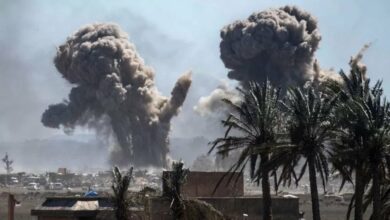

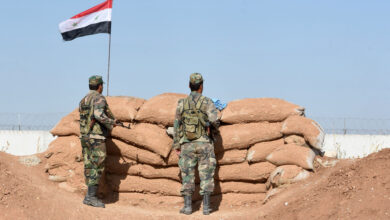
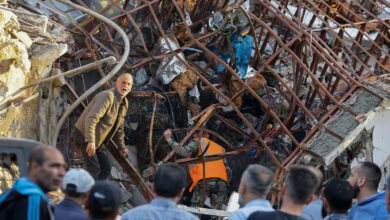

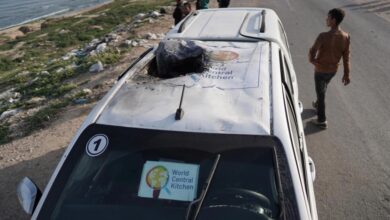
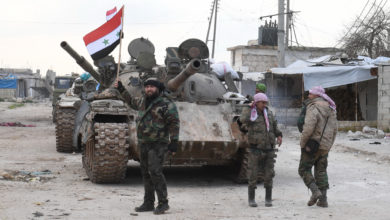
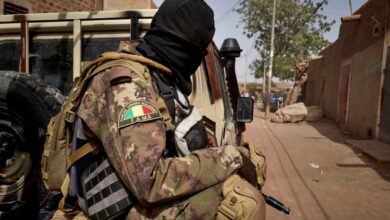
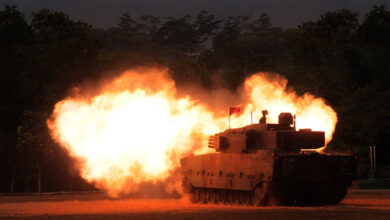
5 Comments